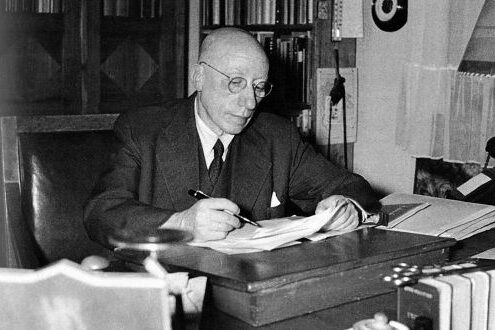Tree, Julius
Art historian
Born: April 9, 1882 in Wiesbaden
died: October 27, 1959 in Stuttgart
Julius Baum was born into the third generation of the respected Jewish Baum family of manufacturers. He was the son of Hermann Baum senior (1850 - 1914), partner in the company Nassauische Leinenindustrie Joseph Maier Baum, and the older brother of the painter Franz Maximilian Baum and cousin of the businessman Joseph Baum. His mother, Julia Anna Baum, née Bloch (1859 - 1911), was a pianist. From 1891 to 1900, Julius Baum attended the humanistic "Königliches Gymnasium zu Wiesbaden" at Luisenplatz (No. 10), where he passed his school-leaving examination in March 1900.
The family's wealth allowed him to pursue the academic career of an art historian instead of a commercial career, contrary to family tradition. He completed his comprehensive studies in art history, history and regional studies in Berlin, Munich and Tübingen in 1905 in Tübingen under Konrad Lange (1855 - 1921) with a dissertation on "Die Kirchen des Baumeisters Heinrich Schickhardt". He then completed a second degree in classical archaeology in Munich. In 1907, he left Judaism, possibly encouraged by his intensive study of Western Christian art. However, it was not until January 1918 that he became a member of the Protestant Bergkirche congregation in Wiesbaden.
Baum began his professional career in January 1908 in Stuttgart at the "Staatssammlung für vaterländische Kunst- und Altertumsdenkmale" (now the Württemberg State Museum). Until the First World War, he worked here as a curator and monument conservator, entrusted with the inventory of Württemberg's art monuments. After his habilitation in 1912 under Heinrich Weizsäcker (1862 - 1945) at the Technical University of Stuttgart with the groundbreaking publication "Die Ulmer Plastik um 1500", which appeared in 1911, he was also a private lecturer at the Technical University and a lecturer at the Stuttgart Academy of Fine Arts.
German nationalist and patriotic, he took part in the First World War as a volunteer from 1914 to 1918. From 1917, as a non-commissioned officer and expert in the context of art protection, he was significantly involved in the inventory of Belgium's architectural and artistic monuments. For his services during the war, Baum was awarded the Cross of the Order of St. Charles in 1917 and the Cross of Honor for Frontline Combatants in November 1934.
After the end of the war, he returned to his posts in Stuttgart and was appointed in 1922. From then on, he was conservator at the State Art Collections (the former State Collection) and at the Württemberg State Office for the Preservation of Monuments, and after Weizsäcker's resignation, he was also full professor of medieval art history until 1933. In 1924, the city of Ulm appointed him director of the municipal museum with the task of redesigning the former Gewerbemuseum and establishing a gallery of modern art. Baum courageously took on this task and the "Museum of the City of Ulm" was reopened in 1925. In 1929, Baum married Emma Gruner (1893 - 1970), the daughter of an Esslingen soap manufacturer, and became the father of a son and a daughter.
In 1933, after the National Socialists came to power, the activities of the committed art historian were abruptly interrupted. Due to his Jewish origins and his museum policy, which was open to contemporary art, Baum was suspended with immediate effect in March, followed by his dismissal in May 1933. Baum left Ulm and moved back to Stuttgart with his family, where he worked as a private lecturer and was constantly spied on by the Gestapo. During the pogrom night in November 1938, he was arrested and imprisoned for more than four weeks in the Welzheim "protective custody camp", east of Stuttgart. In poor health, he managed to escape to Switzerland at the end of February 1939, where the family settled in Bern and Baum continued to work as a scientist. In 1941, he lost his German citizenship and with it his pension entitlements.
Summoned by Theodor Heuss, the then Württemberg-Baden Minister of Culture, Baum returned to Germany in October 1946. From December 1947, he was director of the Württemberg State Museum and honorary professor at the Technical University of Stuttgart. Under his leadership, the museum's removed collections were reunited and presented anew and the reconstruction of the Old Palace was begun. He retired at the end of April 1952, and in May of the same year he was awarded the Federal Cross of Merit. He found his final resting place in his wife's family grave in Esslingen.
Baum's research focused on the art of the Middle Ages and the Renaissance in Germany, particularly in Swabia and Württemberg and south-west Germany, as well as in France, Belgium, Great Britain, Italy and Switzerland. He was also a staunch advocate of contemporary architecture and art. Today, the important art historian, who followed Jacob Burckhardt (1818 - 1897) in seeing the development of art in the context of cultural and intellectual history, is only known in specialist circles, although he achieved outstanding results in all areas of his field. Persecution by the National Socialists and emigration have had a lasting impact on his afterlife and have almost caused him to be forgotten by the wider public.
Literature
- Wendland, Ulrike
Biographical handbook of German-speaking art historians in exile. The life and work of scholars persecuted and expelled under National Socialism, Part 1: A - K, Munich 1999 (pp. 27-31).
- Adams, Myrah
Julius Baum. Museum director between tradition and modernity, Ulm 2005.
